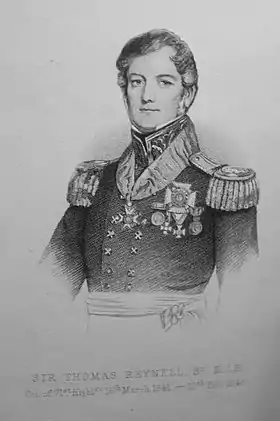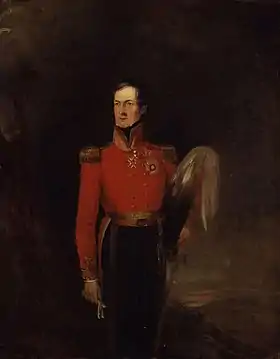Thomas Reynell (British Army officer)
General Sir Thomas Reynell 6th Baronet of Laleham KCB (1777–1848) was a 19th century British Army officer. He was Colonel in Chief of the 71st Highlanders from 1841 to 1848.


The epitome of a "career soldier" he devoted his entire life to the army and saw a great deal of battle action.
Life
His ancestors were the Reynell baronets of Laleham on he River Thames.
He was born in eastern Canada on 9 April 1777 the son of Lt Thomas Reynolds (1746-1777) an officer on active duty (with his wife Anne Carty of Kinsale in nearby quarters) with 62nd Regiment of Foot. His father was involved with the Canadian Campaign under command of Lt Gen John Anstruther. His father was killed at the Battle of Freeman's Farm near Saratoga on 19 September 1777, a few months after his birth. He was shot in the head. Young Thomas was then taken a prisoner of war with his mother and siblings and various captured troops. The Continental Congress of November 1778 authorised their release but this did not occur until May 1779 by which time he was two years old.[1]
Despite this very offputting start he decided on a military career and joined the newly created 38th Regiment of Foot as an Ensign in 1793 shortly after his 16th birthday. This being at the start of the French Revolutionary Wars it may have also been inspired by patriotism. It is not clear if he served in Ireland but he would have sailed to the West Indies and was present at the capture of Martinique in March 1794. He was at the capture of St Lucia in may 1796 and the capture of Trinidad in 1797.[2]
Some time prior to 1805 he transferred to the 71st Highlanders and was raised to the rank of Brevet Colonel. He went to the Cape of Good Hope (against the Dutch) in August 1805 and was part of the Battle of Cape Town in January 1806 in which both his old and new regiment fought. His placement on lighter but very well-paid duties from 1806 to 1808 may indicate an injury. During this period he was Deputy Quartermaster General for India.[3]
He returned to active duties with the 71st Highlanders in June 1808 joining them in Portugal for the Peninsular War. He fought at the Battle of Rolica in "Ferguson's Brigade" fighting the French under Delaborde on 17 August. Four days later he was in the Battle of Vimeiro. On 16 January 1809 he fought with them at the Battle of Corunna his most substantial battle to date.[4]
The regiment returned to England for several months before being sent to fight in the disastrous Walcheren Campaign under Baron Francis de Rottenburg. They returned to England in Spring 1810.[5]
In September 1810 they returned to the Peninsular War. After some months of skirmishes they fought in the major Battle of Fuentes de Onoro (3 to 5 May 1811). Another major conflict occurred on 28 October 1811 when he fought at the Battle of Arroyo dos Molinos in Howard's (1st) Brigade. In May 1812 he fought in the Battle of Almaraz. A year later in June 1813 he was in the Battle of Vitoria - a major bloodbath which saw Wellington victorious. The army pushed the defeated French back into France, involving further conflict: the Battle of the Pyrenees (25 July 1813).[6]
Pursuing the Napoleonic Army they fought the Battle of Nivelle in November and Battle of the Nive in December. Wearing the regiment fought the Battle of Orthez in February 1814. In April they fought what they thought was the final victory over Napoleon at the Battle of Toulouse. This final battle was four days after Napoleon's surrender and served to quell the still militant French forces.[7]
In July 1814 the war-weary regiment was shipped back to England in what they must have thought was the end of this long war. However, following Napoleon's escape and return to power they had to ship to Ostend in April 1815. After searching for the French army south of Brussels the two huge forces met in the farm fields south of the tiny village of Waterloo. The subsequent battle resulted in the true final defeat of Napoleon. Unfortunately Reynell, now a Lt Colonel, was one of the thousands of men who was wounded in this battle.[8]
Again placed on lighter duties he did not go with his regiment to Canada but instead in 1825 returned to India in command of the 1st Infantry Division. Unfortunately this choice placed him at the Siege of Bhurtpore in December 1825/January 1826.[9]
In 1829 Thomas became Baronet of Laleham in Surrey following the death of his older brother Richard Littleton Reynell (b.1772), 5th baronet, who had obtained the baronetcy through an uncle in 1798. Richard appears to have been a baronet in name only and lived the entire duration of his baronetcy in America, rather than the family seat of Laleham.[10]
In 1841 he succeeded Lt Gen Samuel Ford Whittingham as Colonel in Chief following Whittingham's death.[11]
He died on 10 February 1848 at Arundel in Sussex and is buried under a granite monument in the churchyard of St Mary's in Walberton.[12] His will is held in the National Archive at Kew.[13]
Family
In 1831 (aged 54) he married Lady Elizabeth Louisa Pack (1783-1856), widow of Sir Denis Pack,[14] with whom he had served in the Peninsular War. He had written to Pack from 1810 to 1823.[15]
Both were too old to have children. Reynell died childless and the baronetcy died with him.
Artistic Recognition
His portrait by William Salter (of around 1830) shows a very weary soldier. It is held by the National Portrait Gallery, London but is rarely displayed.[16]
References
- "Sir Thomas Reynell (1777-1848) - Find A Grave..." www.findagrave.com. Retrieved 2021-02-05.
- https://www.britnumsoc.org/publications/Digital%20BNJ/pdfs/1915_BNJ_11_14.pdf
- Archives, The National. "The Discovery Service". discovery.nationalarchives.gov.uk. Retrieved 2021-02-05.
- "Battle of Roliça | Peninsular War". www.britishbattles.com. Retrieved 2021-02-05.
- "71st ( Highland) Light Infantry - Regiment History, War & Military Records & Archives". www.forces-war-records.co.uk. Retrieved 2021-02-05.
- Oxford Guide to Battles: Richard Hlmes and M M evans
- "Origins – 71st and 74th". HLI (City of Glasgow Regiment) Association. 2017-03-19. Retrieved 2021-02-05.
- "Origins – 71st and 74th". HLI (City of Glasgow Regiment) Association. 2017-03-19. Retrieved 2021-02-05.
- "HorsePower – January 2015 – The Siege of Bhurtpore 1825". Retrieved 2021-02-05.
- Burke's Perrage: Reynell
- Hildyard, Henry J.T. (1876). Historical Record of the 71st Regiment Highland Light Infantry (PDF). London: Harrison and Sons.
- "Sir Thomas Reynell (1777-1848) - Find A Grave..." www.findagrave.com. Retrieved 2021-02-05.
- Catalogue description Will of Sir Thomas Reynell, Lieutenant General in Her Majestys Army and Colonel of Her... 1848-03-31. line feed character in
|title=at position 22 (help) - "PORTRAIT OF LADY ELIZABETH PACK, c.1850s at Whyte's Auctions | Whyte's - Irish Art & Collectibles". Whyte's. Retrieved 2021-02-05.
- "Pack and Reynell papers - Archives Hub". archiveshub.jisc.ac.uk. Retrieved 2021-02-05.
- Salter, William (1834–1840). "Sir Thomas Reynell, 6th Bt". National Portrait Gallery.CS1 maint: date format (link)